Gochujang Fried Rice With Kimchi
Korean gochujang fried rice is a delicious plant-based one-pan meal. The gochujang sauce and fermented kimchi add a spicy and flavourful umami kick. And dinner is on the table in less than 15 minutes when you have leftover rice.
Gochujang fried rice is a delicious and easy weeknight meal. It’s umami-packed thanks to Korean gochujang paste and fermented kimchi. But the best of all? You can get this one-pan meal on the dinner table in under 15 minutes.
This spicy Korean fried rice recipe yields a quick and easy plant-based meal. Enjoy it as a vegan main dish. Or treat it as a blank canvas and add anything from ground beef and leftover veggies to plant-based protein to bulk up the fried rice.
I like to top the spicy gochujang rice with a crispy fried egg for extra richness and crunchy roasted seaweed. But you do you!
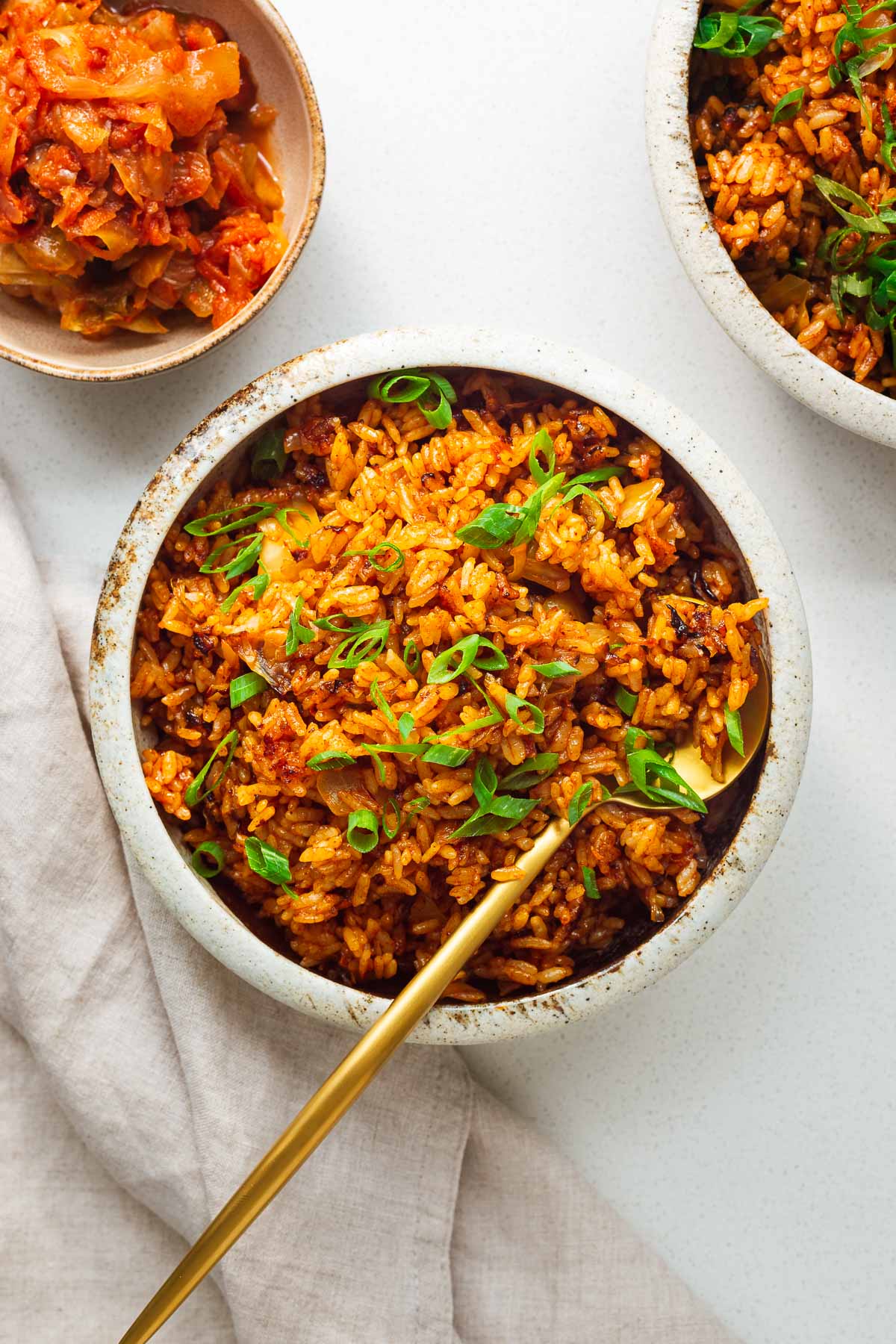
Why you’ll love this recipe
This gochujang fried rice recipe is a flavourful and easy weeknight meal and there are many reasons to love it:
- It’s vegan-friendly: The fried rice recipe is vegan as written. You can top it with a plant-based protein like crispy tofu, or add a fried egg for those who don’t need it to stay vegan.
- It’s super versatile: I love Korean-style fried rice with leftover medium-grain rice. But you can use any leftover rice, white or brown rice.
- It’s great for a fridge raid: Add any of those veggies lurking in the back of the fridge, or grab a handful of frozen edamame beans – anything goes!
- It’s flavour-packed: The gochujang sauce (Korean chilli paste) is a gorgeous balance of sweet, spicy, salty and tangy. And along with funky kimchi, it results in an umami-packed flavour profile without any effort.
- It’s great for meal prep: Cook up a batch of medium- or short-grain white rice, refrigerate and use it in the week to make your spicy Korean fried rice with gochujang in under 15 minutes. Always reheat leftover rice until piping hot. You can also make a double batch of the gochujang sauce and add it to noodles and Korean rice bowls (bibimbap).
What is gochujang paste?
Gochujang paste is an essential condiment in Korean cuisine. It’s a savoury-sweet fermented red pepper paste made from Korean red chilli peppers, glutinous rice, fermented soybeans, and salt.
This spicy-sweet paste is a popular ingredient in Korean food, from side dishes (banchan) to main dishes and breakfasts. It adds a unique and complex flavour to any dish.
Use it in a marinade, a dipping sauce, a stir-fry sauce, and even fried rice (like this Korean gochujang fried rice recipe).
Try more recipes with gochujang
- Spicy Korean gochujang noodles
- Gochujang fried rice with kimchi
- Homemade bibimbap sauce
- Gochujang mayo
- Spicy gochujang eggs (perfect on toast or rice)
More about my favourite secret ingredient gochujang and how to use it.
Gochujang fried rice ingredients and substitutes
This fried rice with gochujang packs a serious flavour punch. And it’s a great way to use up leftover rice. The recipe is also super flexible, so feel free to play around with the ingredients and adjust them to your taste.
- Kimchi: Korean kimchi adds a spicy, acidic kick to the fried rice. And I love to layer cooked and raw kimchi for extra Korean flavour. But if you’re not a fan, you can swap it for napa cabbage stir-fried with minced fresh ginger and red pepper flakes to add a similar same fiery crunch.
- Gochujang paste: Gochujang is a spicy, sweet, and savoury Korean red chilli paste. It’s available in different levels of spiciness, so adjust the amount based on your spice level preference. If you don’t have gochujang paste, try my homemade gochujang substitute or any other option from the list that suits your pantry.
- Kimchi juice: I love including flavourful kimchi juice in my cooking. But if your kimchi is not very juicy, add a squeeze of lime juice or a splash of rice vinegar for acidity.
- Soy sauce: Use light or all-purpose soy sauce, or tamari or coconut aminos as a gluten-free option. (Though it is important to remember that traditional Korean gochujang paste is not gluten-free!)
- Cooking oil: Use a neutral cooking oil like canola, vegetable oil or avocado oil to fry the rice.
- Green onion: Slice the white and green parts of the onion. Reserve some green slices for garnish. Or garnish with fresh chives.
- Garlic: I use freshly minced garlic. But if you’re in no mood to chop garlic, mix a teaspoon of garlic powder into the gochujang sauce for a more subtle garlic flavour.
- Rice: Korean fried rice works best with day-old medium- or short-grain rice. I use Korean medium-grain rice. But you can use what you have (it might not crisp up the same though the gochujang flavours will still be great).
If you don’t have leftover day-old rice, you can use freshly cooked rice, but let it cool down completely before using. Use your instant pot for short- or medium-grain rice, or try this stovetop sushi rice recipe that works for short- and medium-grain rice.
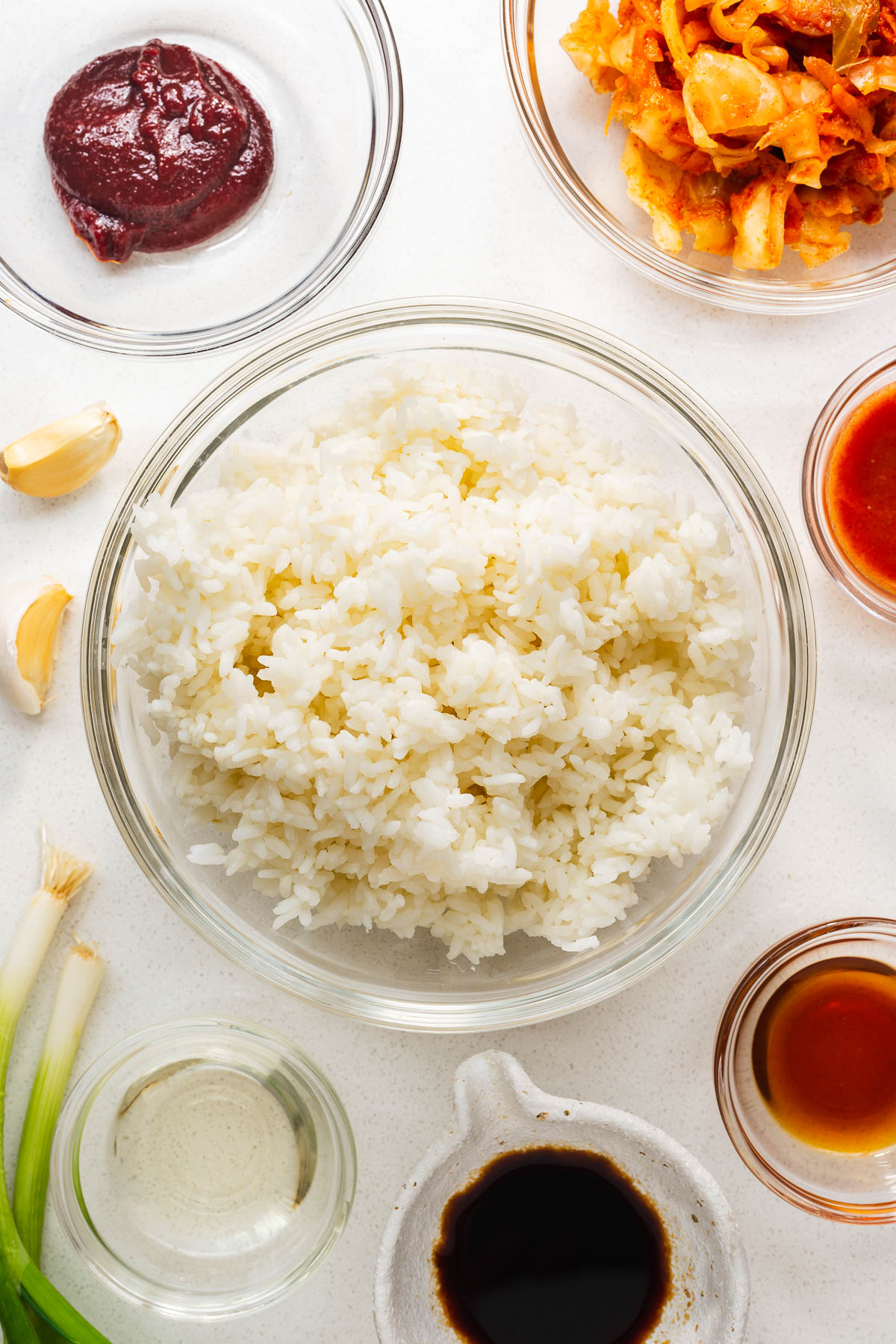
Optional add-ins and toppings
Consider this delicious spicy Korean rice recipe as a blank canvas. And add any of those veggies lurking at the back of the fridge. Stir-fried shiitake mushroom, bell peppers, chopped green beans, bok choy, or napa cabbage all work great.
You can also add a plant-based protein like tofu, or if you don’t need the Korean fried rice to stay vegan, add some leftover cooked chicken for easy chicken fried rice.
I like to top the fried rice with a crispy fried egg, more raw kimchi and a sprinkle of gochugaru (Korean pepper flakes) for extra heat. And, for bonus umami, I love to crunch a small snack pack of Korean roasted seaweed over the fried rice.
How to make gochujang fried rice
Gochujang fried rice is a flavourful, spicy and easy weeknight dinner. And with these simple steps, you can get a bowl of gochujang fried rice on the table in 15 minutes.
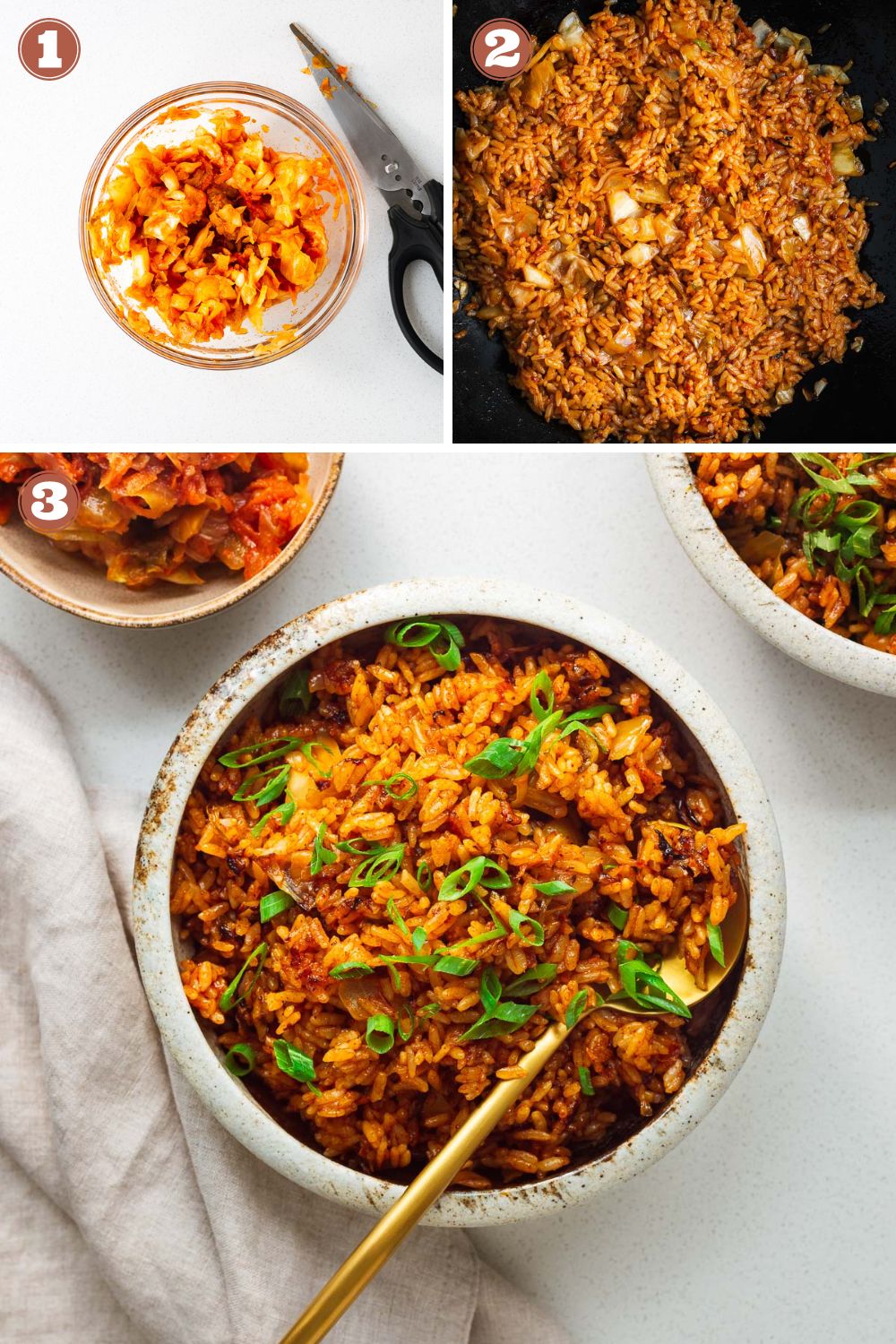
Step 1: Ingredient prep
Mince your garlic cloves and finely slice the green onions diagonally, white and green parts (reserving a few green pieces).
Place the kimchi in a bowl and use clean kitchen scissors to cut the kimchi into smaller pieces. You can also chop it with a knife, but I find the scissors easier.
For your gochujang fried rice sauce, whisk together the sesame oil, gochujang, kimchi juice and soy sauce in a small bowl and set aside.
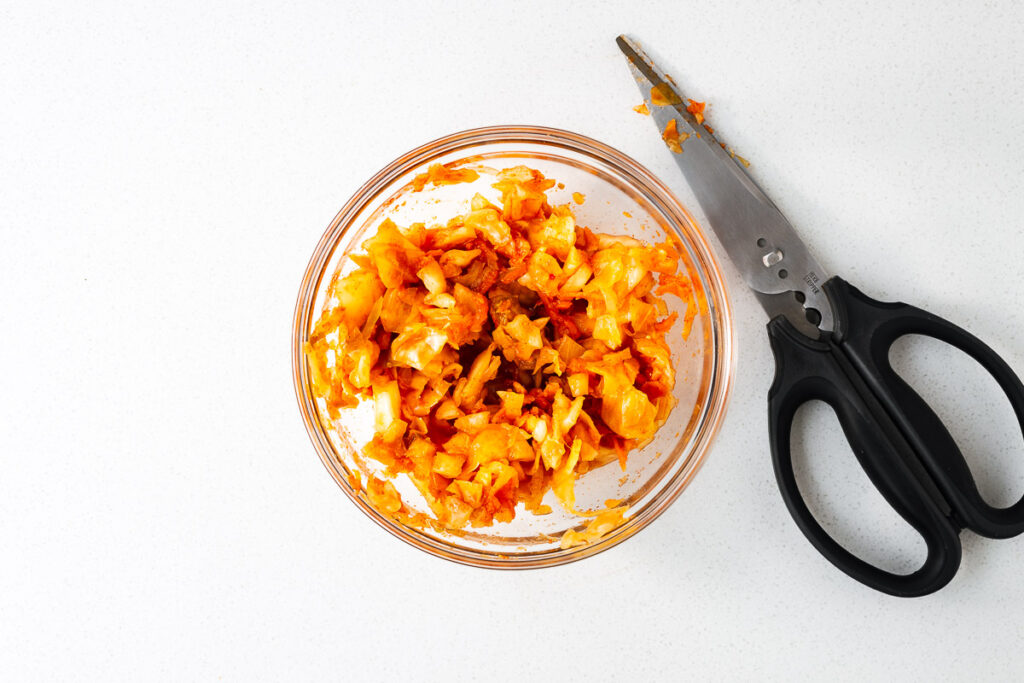
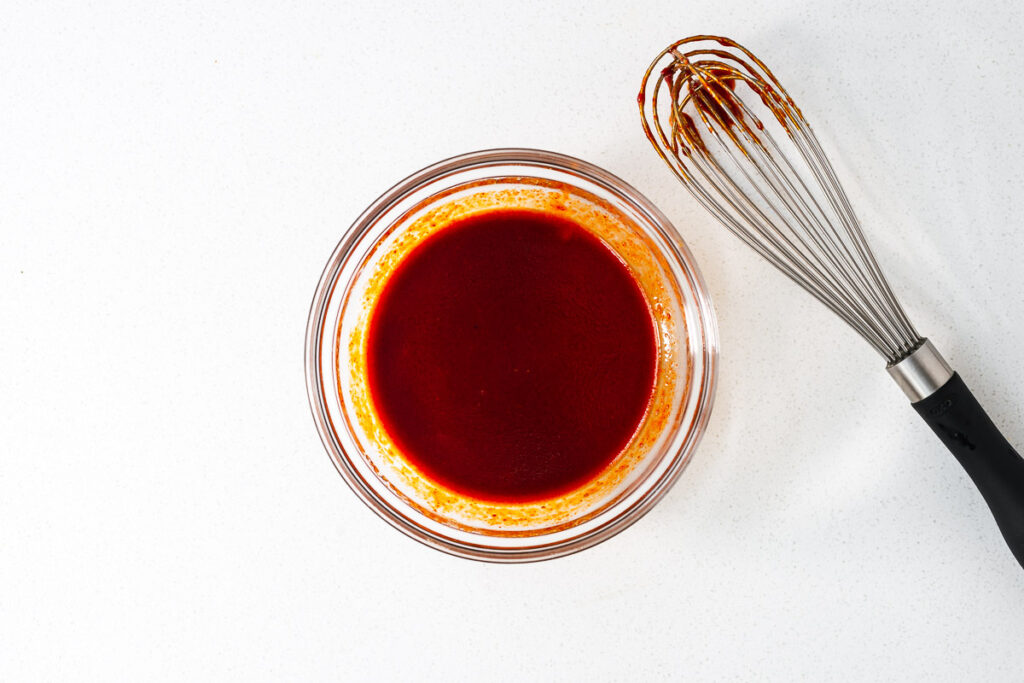
Step 2: Stir-fry
Heat a tablespoon of neutral cooking oil in a seasoned wok or large non-stick frying pan over medium-high heat. When the oil shimmers, add the green onions and cook for a minute before adding the minced garlic.
Stir-fry for another minute until the garlic is fragrant. Then add the kimchi for another minute of stir-frying.
Place the cooked rice on top of the kimchi in your pan. Then pour over the bowl of gochujang sauce. Stir-fry everything together until the rice is evenly coated in the sauce – about three minutes.
Then use the back of your spoon to gently press the rice into the pan (like you’re making a big fried rice pancake). Reduce the heat to medium and let the rice caramelise in the pan for two minutes.
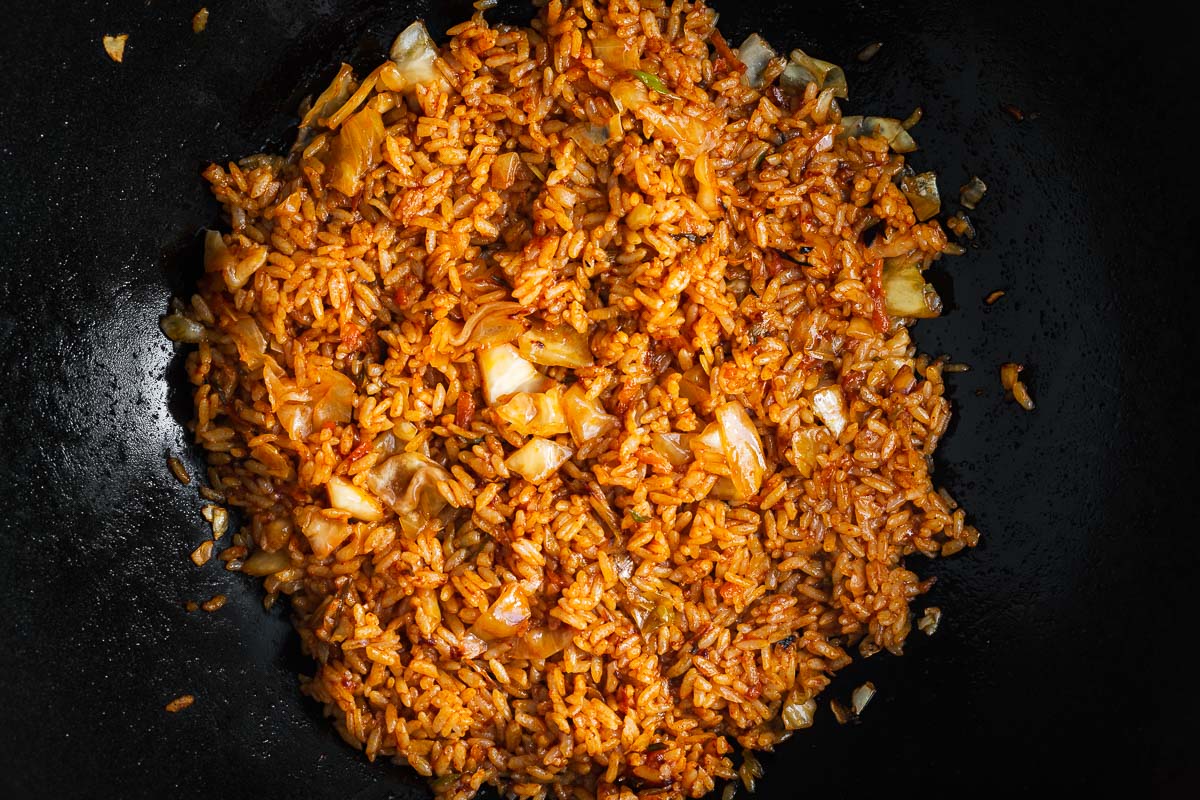
Step 3: Serve
Transfer the kimchi fried rice to a bowl and scatter with the reserved spring onions.
Serve the gochujang fried rice with more kimchi and other banchan (Korean side dishes). See the serving suggestions for more ideas.

Serving suggestions
This flavourful Korean-style fried rice is a great vegan one-pan meal for two. But you can also bulk it up with some protein or serve it as a side.
Add a protein: I like to top my Korean fried rice with a sunny-side-up fried egg or umami-packed mayak eggs (Korean soy-marinated eggs). But you can also add pre-cooked proteins (or leftovers) like rotisserie chicken for easy chicken fried rice. Use your air fryer for quick crispy tofu cubes if you’re after a plant-based protein.
Add a sprinkle: Crush a small packet of Korean roasted seaweed (gim) and sprinkle over your fried eggs. Or add a tablespoon of toasted sesame seeds. And I always like to finish things off with an extra helping of kimchi – adding uncooked kimchi at the end layers the kimchi umami flavour.
Serve it with banchan: Serve the spicy fried rice as a main course surrounded with Korean banchan – like sesame broccoli salad, spicy cucumber salad, green onion salad and soy-braised potatoes.
Frequently asked questions
Gochujang is a Korean fermented red chilli paste that adds a unique sweet and spicy flavour to dishes. It is a common ingredient in Korean dishes like bibimbap, kimchi stew (kimchi jjigae), and gochujang fried rice.
Yes, gochujang is absolutely worth buying! It adds a uniquely Korean spicy flavour to soups, stews, marinades and sauces. And, properly refrigerated, it stays fresh for months.
Korean fried rice typically uses short- or medium-grain leftover rice and may include gochujang, sesame oil, and kimchi for a unique flavour and a touch of spicy heat. Chinese restaurant-style fried rice uses Jasmine rice (long-grain rice).
You can, but gochujang paste is not a stand-alone condiment. It is best used to season dishes like Korean fried rice, bibimbap, and kimchi stew. Or use it to make Korean bbq sauce or gochujang mayo.

Ingredients
- 1 cup kimchi , and more for serving
- 2 tablespoons gochujang , or more to taste
- 2 tablespoons kimchi juice
- 1 tablespoon soy sauce
- 1 teaspoon toasted sesame oil
- 1 tablespoon cooking oil
- 2 green onions , thinly sliced on the diagonal (reserve some green slices for garnish)
- 2 cloves garlic , minced
- 3 cups cooked white rice* , preferably day-old rice
Instructions
- Place the kimchi in a bowl and use clean kitchen scissors to cut the kimchi into smaller pieces. You can also chop it with a knife, but I find the scissors easier.
- In another small bowl, mix the gochujang, kimchi juice, soy sauce and sesame oil and set it aside.
- Heat the cooking oil in a seasoned wok or large nonstick skillet over medium-high heat. When the oil shimmers, add the green onions and cook for a minute before adding the minced garlic. Cook for another minute until the garlic is fragrant – stirring now and then. Then add the kimchi and sauté for another minute.
- Add the cooked rice on top of the kimchi. Then pour over the bowl of gochujang sauce. Stir-fry everything together for 3 minutes. Then use the back of your spoon to gently press the rice into the pan (like you're making a big fried rice pancake). Reduce the heat to medium and let the rice caramelise in the pan for 2 minutes.
- Transfer the kimchi fried rice to a bowl and scatter with the reserved spring onions. Serve alongside more kimchi.
Notes
- Gochujang paste is available in different levels of spiciness: Mild, Slight Hot, Medium Hot, Very Hot and Extreme Hot. I buy mine medium hot. Find more information on gochujang and how to substitute it if you’ve run out. If you’re worried about overly spicy fried rice, start with one tablespoon of gochujang, taste the sauce, and add the second tablespoon if you want more heat. Or sprinkle the fried rice with gochugaru (Korean chilli flakes) for extra heat.
- Korean fried rice works best with day-old medium- or short-grain rice. I use Korean medium-grain rice. But you can use what you have (it might not crisp up the same though the flavours will still be great).
- If you don’t have leftover day-old rice, you can use freshly cooked rice, but let it cool down completely before using it.
- Refrigerate leftover Korean fried rice in an airtight container for up to 3 days and reheat thoroughly before serving.

This fried rice looks fantastic. Thanks for the recipe.
Thank you, Kushigalu!
This is so flavorful! Definitely making it again.
Yay! So happy to hear you enjoyed the fried rice, Luci.
This recipe hit the spot. So delicious. I love Korean food and the spices on this fried rice recipe are perfect. Great side dish!
Thank you so much, Jayne! I am so happy you enjoyed the flavours! I also love Korean food.
I can’t wait to try this. I love fried rice, but I’ve never had it this particular version before. It looks delicious.
Hi Beth! If you love fried rice, I’m sure you will love this Korean version! The gochujang and kimchi add loads of flavour with minimal effort.
This was delicious! So much flavor and super easy to make – a great way to use up leftover rice, too!
Thank you, Justine. I always make sure I have leftover rice just so I can make gochujang fried rice the next night!